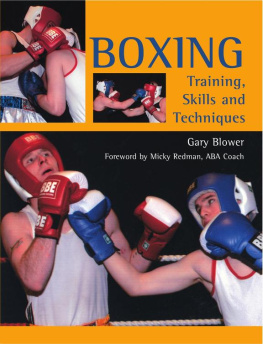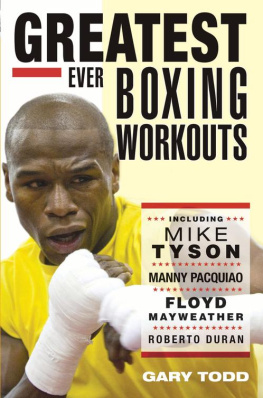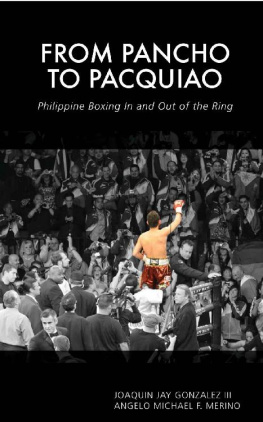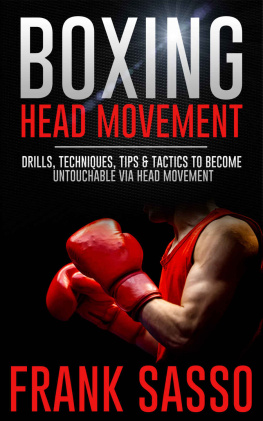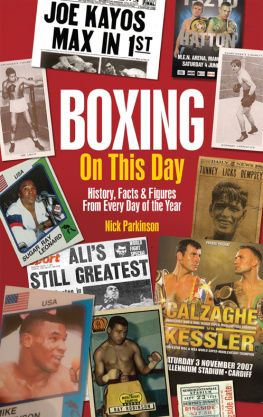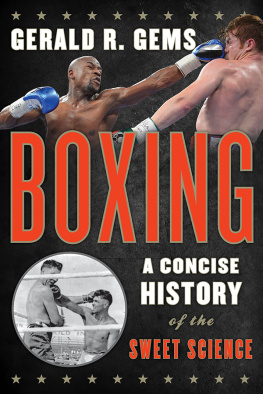BOXIANA
VOLUME 1
AN ANTHOLOGY OF NEW BOXING WRITING
EDITED BY LUKE G. WILLIAMS
Copyright 2014 Luke Williams (Editor) and individual authors.
The moral right of the author has been asserted.
Apart from any fair dealing for the purposes of research or private study, or criticism or review, as permitted under the Copyright, Designs and Patents Act 1988, this publication may only be reproduced, stored or transmitted, in any form or by any means, with the prior permission in writing of the publishers, or in the case of reprographic reproduction in accordance with the terms of licences issued by the Copyright Licensing Agency. Enquiries concerning reproduction outside those terms should be sent to the publishers.
Matador
9 Priory Business Park
Kibworth Beauchamp
Leicester LE8 0RX, UK
Tel: (+44) 116 279 2299
Fax: (+44) 116 279 2277
Email: books@troubador.co.uk
Web: www.troubador.co.uk/matador
ISBN 978 1784627 287
Cover art by Trevor Von Eeden
Illustrations of Jack Johnson, Deontay Wilder, Wladimir Klitschko and
Chris Byrd by Trevor Von Eeden
Photograph of Len Sparrowhawk courtesy of Ben Williams
Matador is an imprint of Troubador Publishing Ltd
To my father,
who taught me the importance of sport
CONTENTS
Round 1:
Introduction by Luke G. Williams
Round 2:
Pugilistic Comic Books Come Full Circle by Luke G. Williams
Round 3:
The Story Behind The Original Johnson by Trevor Von Eeden
Round 4:
A New Hope by Luke G. Williams
Round 5:
The Klitschko Conundrum by Corey Quincy
Round 6
A Night At The Fight by Rowland Stone
Round 7:
Invisible While Standing Still by Luke G. Williams
Round 8:
This Boxers Life by Chris Hobbs
Round 9:
Diary Of A Fight Novice by Mario Mungia
Round 10:
A Boxing Afterlife by James Hernandez
Round 11:
For Whom The Bell Tolls by Matthew Ogborn
Round 12:
Bare-Knuckle Grandfather by Ben Williams
ROUND 1
INTRODUCTION
Welcome to the first volume of Boxiana! Well, thats not strictly true, for long-time fans of the pugilistic arts will recognise that the title of this new boxing anthology is shamelessly cribbed from Pierce Egans Georgian journalistic masterpiece, the popularity of which did so much to immortalise the feats of early fistic heroes such as Tom Cribb, Bill Richmond and Tom Molineaux and establish organised bare-knuckle combat (the forerunner to modern boxing) as a social and sporting phenomenon.
This modest volume could never hope to scale the immortal heights reached by Egans meisterwerk, which pretty much invented sports journalism. Instead my aim is to present readers with a mixture of interesting and insightful writing, focused on any area of boxing that someone feels passionately enough to write about. This volume, as well as planned future volumes, will aim to give a voice to as many talented and passionate writers as possible. The only entry criteria for Boxiana is that you have the cojones and talent to send a proposal or piece of writing that I like the more original and creative the better!
What then inspired the publication of this volume? Truth be told, the main reason is slightly egotistical; it has quite simply been a dream of mine for many years to edit my own boxing anthology. During six years as a professional sports journalist, I all too infrequently got the opportunity to cover the sport that I love above all others and, in the ten years since I left full-time journalism to pursue a teaching career, a nagging regret has festered in the back of my brain that I had perhaps missed out on my true vocation (see, I told you this was egotistical) Boxing was always a sport that excited my imagination as a child; when I think back to those halcyon bucket-and-spade days, it is boxing that often serves as a prompt for my inexorably decaying memory For example, I cannot recall much else that happened to me in 1986, but I can still distinctly recall the excitement in my fathers voice when he entered the living room early one morning to inform me that Lloyd Honeyghan, who lived in our area of south London, had beaten Don Curry (the best boxer in the world, and an American at that!) to become World Welterweight Champion. That Honeyghan so frequently referred to the Walworth Road, where we did our Saturday morning fruit and veg shopping, only added to my excitement. (By the way, I tried every week to spot Lloyd wandering down the Walworth Road and never did, although my dad claimed he saw him in the betting shop once).
Similarly, I can still recall my utter incredulity when I discovered that Mike Tyson had been knocked out by James Buster Douglas in February 1990. The pre-internet age meant that anyone who missed the news late on Sunday night or early on Monday morning was utterly unaware that such a seismic event had taken place. I remember several of my friends at school refusing to believe the small group of us who told them that Tyson had lost. The matter was only settled when we snuck out of the playground at lunchtime and got our hands on an early edition of the London Evening Standard in order to confirm that Tyson had, indeed, been humbled. I think there was even a photo of him fumbling for his mouth-guard which ended up being snipped out of the Standard and excitedly passed around the back of the class.
However, childhood reverie to one side, it was not my attachment to boxing as a child that instilled in me the ambition to be a boxing writer or editor. No, that ambition actually came later, during my teenage years when I discovered a volume of boxing writing that simply blew my mind Mailers The Fight? I can almost hear you ask. Lieblings The Sweet Science? The aforementioned Egans Boxiana? Sorry, but it was none of these instead it was a paperback volume that the majority of boxing fans have probably never encountered, entitled Champions of the Ring by Gerald Suster, published by Robson Books in 1994 which consisted of a series of biographical essays of the most significant heavyweight champions from John L. Sullivan to Lennox Lewis. Suster, I later discovered, wasnt always the most accurate of authors. For example, his claim that Ezzard Charles was the boxer on the cover of Sgt. Peppers Lonely Hearts Club Band once lost me a pub quiz, to the chagrin of a Beatles-loving friend, who had maintained it was Sonny Liston, only to be over-ruled (incorrectly) by me. Nevertheless, there was something in Susters excitable and vivid prose that captured my imagination; the pithy phrases he coined to describe the fistic heroics of the likes of Ali, Johnson and Dempsey stuck in my mind and that of my best boxing friend from school, James we would wile away hours studying and reciting passages from the book until we knew them by heart: Jack Johnson was, in Susters estimation, a flawed man of his flawed times; but ... what times! And what a man!, while Primo Carnera was perfectly summarised as the innocent immigrant, fractured freak and crying clown. Even today, when discussing matters related to boxing (or indeed, matters relating to anything), James and I will pepper our conversations with a Suster-ism or two; of a strange or puzzling friend or acquaintance we might remark scratch a paradox and you find an enigma (Susters description of Jack Sharkey), while we often find ourselves affixing Susters pithy assessment of Mike Tyson (what a waste!) to all manner of situations.
During the years when Champions of the Ring was effectively my Bible, the mental image I created of the mysterious Suster, of whom there was very little information and no photographic representation in the pages of the book itself, was of a bespectacled Harry Carpenter/ Reg Gutteridge-type figure, sat in a suburban home sipping from a mug of cocoa while watching old fight videos. Imagine my surprise then, when I read an obituary of Suster, who died in 2001, and discovered that, aside from boxing, his other literary efforts mainly focused on the occult. He was even once the victim of a
Next page


